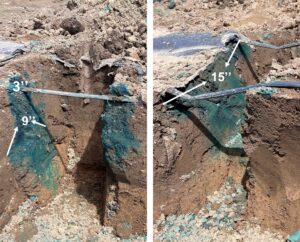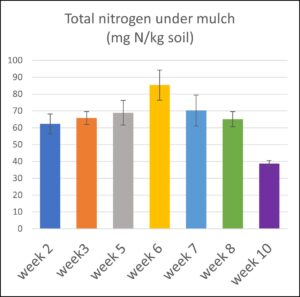We discussed wetting patterns in drip irrigation in a previous article. The take home message is drip irrigation applies water to only a portion of the soil. Uneven water distribution in the soil profile is not a problem as long as enough water is applied to the crop. However, the water wetting pattern might influence the effectiveness of soil-incorporated amendments and drip-applied pesticides. In this article, we will expand on the first aspect, and discuss how water affects the efficacy of soil-incorporated fertilizers and other soil amendments in vegetable production in two production systems, i.e. high tunnel and open-field.
Drip irrigation is the primary irrigation method for growing tomatoes, cucumbers, and peppers in high tunnels. Since high tunnels block natural precipitation, irrigation is often the only water source in the high tunnel. Many high tunnel growers use compost or other amendments incorporated into the soil to maintain soil fertility or adjust soil pH. Organic matter decomposition and sulfur-facilitated soil acidification are microbial activities that require constant soil moisture. If only a portion of the soil is maintained moist, it is likely only soil amendments placed where the soils are moist contribute to crop production. Because wetting the entire area is critical in ensuring soil amendment efficacy, farmers should consider overhead irrigation after applying the soil amendments inside high tunnels. In addition, high tunnel growers should consider using drip tapes with closer emitter spacing and/or multiple drip tapes on each bed during the production season. Figure 1 shows how different drip irrigation setups affect wetting patterns on the beds.

Figure 1. Irrigation dye demonstration to compare wetting pattern of one single drip tape vs. two drip tapes on a bed at Pinney Purdue Vegetable Field Day (Credit: Irrigation educator Lyndon Kelley). The drip tape in the demonstration was 12’’ emitter spacing and 0.4 gpm/100 ft flow rate at 8 PSI and ran for an hour at 10 PSI.
Farmers will likely use synthetic fertilizers, such as urea, in open-field vegetable production. Similar to organic amendments, synthetic fertilizers require water to fulfill their function. Urea turns to ammonium after being in contact with water through a chemical process (urea hydrolysis); it then turns to nitrate through a biological process (nitrification) which requires moisture, oxygen, and suitable temperature. Unlike high tunnel production, crops receive natural rainfall in the open field. Depending on the timing and amount of the rain, it could significantly impact the nutrient availability of preplant-applied fertilizers. Figure 2 shows a case study (conducted in the 2021 watermelon season) of how soil inorganic nitrogen content in the plastic mulch-covered beds changed throughout the season. We found the nitrogen content was at the highest level in week 6 after transplanting, which corresponded to a few rainfalls that happened around middle June in 2021 after an extended dry period. The rains wetted the beds and made most nutrients available for the crops.

Figure 2. Soil inorganic nitrogen content in the plastic mulch-covered beds during the 2021 watermelon season. 150 lb N/acre as urea was broadcast before building the beds and laying plastic mulch.
Funding for project Improve Drip Irrigation Management for Vegetables and Melon Production in Indiana was made possible by the Indiana State Department of Agriculture through grant A337-22-SCBG-21-003. Its contents are solely the responsibility of the authors and do not necessarily represent the official views of the ISDA.